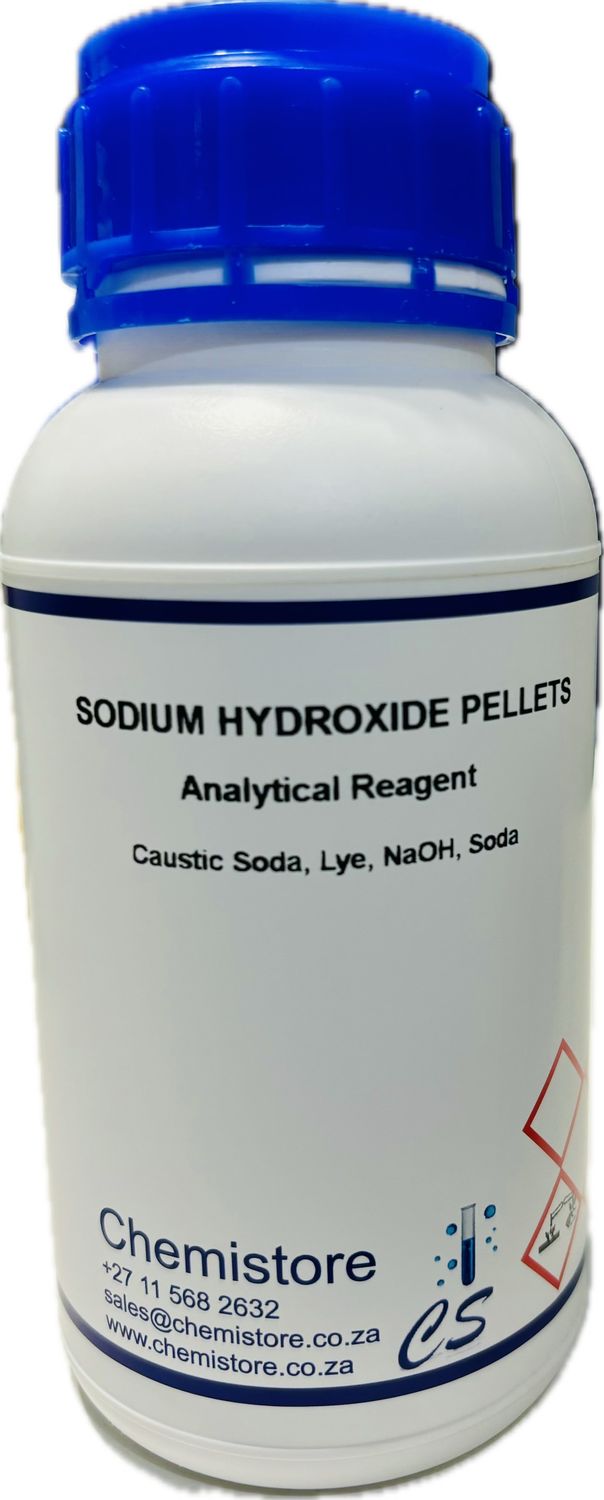🎄Wishing you a joyful festive season and a prosperous New Year.Please note that we will be closed for the festive break from 12 December 2025 and will reopen on 7 January 2026.Orders placed during this period will be processed once we reopen.✨ Thank you for your continued support — we look forward to serving you in 2026!
Sodium hydroxide pellets AR, 500g
R187.03
1
Save this product for later
Sodium hydroxide pellets AR, 500g
Product Details
Molecular Formula: NaOH
• Caustic soda
Synonyms: • Lye
• Sodium oxidanide
CAS Number: 1310-73-2
Molecular Weight: 39,997 g/mol
Description:
Sodium hydroxide is a corrosive white crystalline solid that contains the Na+ (sodium) cation and the OH− (hydroxide) anion. It readily absorbs moisture until it dissolves. Sodium hydroxide is the most widely used industrial alkali and is often used in drain and oven cleaners. It is highly corrosive to animal and vegetable tissue. The alkaline solutions it forms when dissolved in water neutralize acids in various commercial processes. In petroleum refining, it removes sulfuric and organic acids. In soap-making, it acts on natural fats or oils, such as tallow or vegetable oil, to produce sodium fatty acid salt (soap) and glycerin (or glycerol); this saponification reaction is the basis for all soap-making.Safety:
Sodium hydroxide is a potentially dangerous substance. It can hurt you if it touches your skin, if you drink it or if you breathe it. Eating or drinking sodium hydroxide can cause severe burns and immediate vomiting, nausea, diarrhea or chest and stomach pain, as well as swallowing difficulties. Damage to the mouth, throat and stomach is immediate. Breathing it can cause severe irritation of the upper respiratory tract with coughing, burns and difficulty breathing.
The harmful effects of sodium hydroxide depend on several factors including the concentration of sodium hydroxide, length of time exposed, and whether you touched it, drank it or inhaled it. Contact with very high concentrations of sodium hydroxide can cause severe burns to the eyes, skin, digestive system or lungs, resulting in permanent damage or death. Prolonged or repeated skin contact may cause dermatitis. Repeated inhalation of sodium hydroxide vapor can lead to permanent lung damage.
Description of first aid measures
Move exposed individual to fresh air. Loosen clothing as necessary and position individual in a comfortable position.Seek medical advice if discomfort or irritation persists. If breathing difficult, give oxygen.
After skin contact: Take off contaminated clothing and shoes immediately.Wash affected area with soap and water. Seek medical attention if irritation, discomfort persist.
After eye contact: Protect unexposed eye. Rinse/flush exposed eye(s) gently using water for 15-20 minutes. Remove contact lens(es) if able to do so during rinsing. Immediately get medical assistance.
After swallowing: Rinse mouth thoroughly. Do not induce vomiting. Have exposed individual drink sips ofwater. Seek medical attention if irritation, discomfort or vomiting persists.
Display prices in:ZAR


